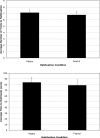Visual exploration strategies and the development of infants' facial emotion discrimination
- PMID: 21833241
- PMCID: PMC3153790
- DOI: 10.3389/fpsyg.2010.00180
Visual exploration strategies and the development of infants' facial emotion discrimination
Abstract
We examined the role of visual exploration strategies in infants' discrimination between facial emotion expressions. Twenty-eight 6- to 11-month olds were habituated to alternating models posing the same expression (happy N = 14/fearful N = 14) as eye gaze data were collected with a corneal reflection eye tracker. Gaze behavior analyses indicated that duration of gaze to the eyes and mouth was similar, consistent with what would be expected based on area subtended by those regions, and negatively correlated. This pattern did not differ as a function of age, sex, or habituation condition. There were no posthabituation performance differences as a function of age group (6- to 8-month- versus 9- to 11-month olds). Only infants habituated to happy faces showed longer looking at the novel emotion (fear) when the model was held constant from habituation to test. We found no reliable correlation between this performance and proportion of gaze directed at any one facial region. Consistent with previous work, the group habituated to fear faces showed no reliable posthabituation novelty preference. Individual differences in gaze behavior shed light on this finding. Greater proportion of gaze directed at the eyes correlated positively with preference for the novel emotion (happy). These data suggest that, as in other object classes, visual exploration strategies are an important agent of change in infants' capacity to learn about emotion expressions.
Keywords: emotion expression; face perception; infancy; visual exploration.
Figures





Similar articles
-
The discrimination of expressions in facial movements by infants: A study with point-light displays.J Exp Child Psychol. 2023 Aug;232:105671. doi: 10.1016/j.jecp.2023.105671. Epub 2023 Mar 30. J Exp Child Psychol. 2023. PMID: 37003155
-
Dynamic emotional messages differentially affect 6-month-old infants' attention to eyes and gaze cues.Infant Behav Dev. 2021 Aug;64:101626. doi: 10.1016/j.infbeh.2021.101626. Epub 2021 Aug 11. Infant Behav Dev. 2021. PMID: 34390965
-
The effects of adults' affective expression and direction of visual gaze on 12-month-olds' visual preferences for an object following a 5-minute, 1-day, or 1-month delay.Br J Dev Psychol. 2011 Mar;29(Pt 1):64-85. doi: 10.1348/026151010X512088. Br J Dev Psychol. 2011. PMID: 21288254
-
Infants' visual exploration strategies for adult and child faces.Infancy. 2022 May;27(3):492-514. doi: 10.1111/infa.12458. Epub 2022 Jan 24. Infancy. 2022. PMID: 35075767
-
Meta-analytic review of the development of face discrimination in infancy: Face race, face gender, infant age, and methodology moderate face discrimination.Psychol Bull. 2017 Nov;143(11):1201-1244. doi: 10.1037/bul0000116. Epub 2017 Jul 31. Psychol Bull. 2017. PMID: 28758764 Review.
Cited by
-
The cascading development of visual attention in infancy: Learning to look and looking to learn.Curr Dir Psychol Sci. 2023 Oct;32(5):410-417. doi: 10.1177/09637214231178744. Epub 2023 Jul 4. Curr Dir Psychol Sci. 2023. PMID: 38107783 Free PMC article.
-
Puppets facilitate attention to social cues in children with ASD.Autism Res. 2021 Sep;14(9):1975-1985. doi: 10.1002/aur.2552. Epub 2021 Aug 4. Autism Res. 2021. PMID: 34350712 Free PMC article.
-
Visual scanning of male and female bodies in infancy.J Exp Child Psychol. 2018 Feb;166:79-95. doi: 10.1016/j.jecp.2017.08.004. J Exp Child Psychol. 2018. PMID: 28888194 Free PMC article.
-
A developmental model of audio-visual attention (MAVA) for bimodal language learning in infants and robots.Sci Rep. 2024 Sep 3;14(1):20492. doi: 10.1038/s41598-024-69245-2. Sci Rep. 2024. PMID: 39242623 Free PMC article.
-
Social complexity and the early social environment affect visual social attention to faces.Autism Res. 2019 Mar;12(3):445-457. doi: 10.1002/aur.2060. Epub 2019 Jan 10. Autism Res. 2019. PMID: 30632286 Free PMC article.
References
-
- Cohen L. B., Atkinson D. J., Chaput H. H. (2004). Habit X: A New Program for Obtaining and Organizing Data in Infant Cognition Studies (Version 10). Austin: University of Texas
Grants and funding
LinkOut - more resources
Full Text Sources

